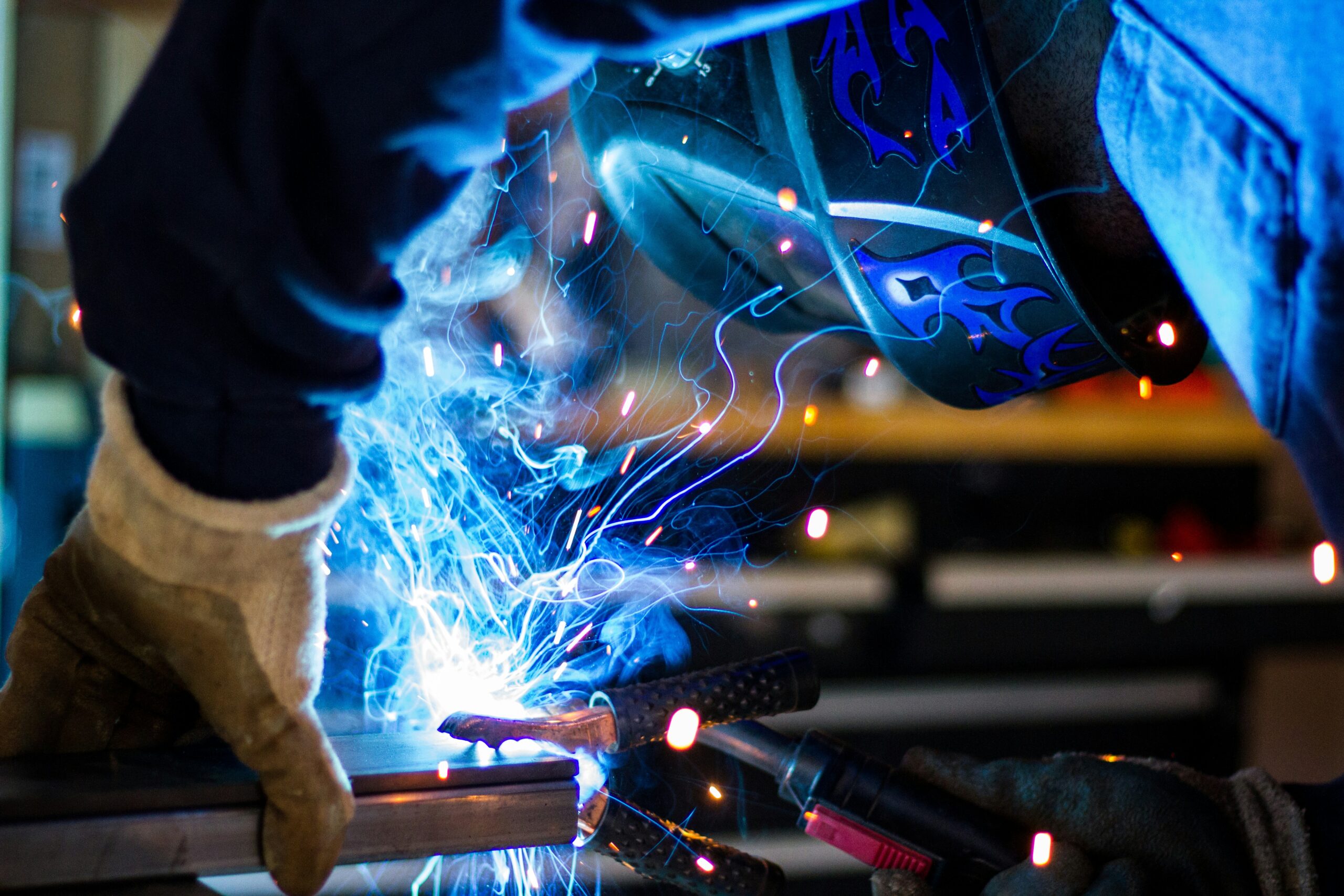Arc welding is a fundamental process in metal fabrication, construction, and repair. The quality of an arc weld is significantly influenced by the type of welding rod (or electrode) used. Choosing the right welding rod involves understanding the characteristics of various rods, their applications, and how they interact with different metals and welding conditions.
This comprehensive guide delves into the best arc welding rods available, covering their features, advantages, and suitable applications to help both novice and experienced welders make informed decisions.
Table of Contents
ToggleTop Picks
- The product is LB 3/32 6013 Weld Rod
- Easy to use
- All position welding, general purpose rod for shallow penetration or in poor fit up conditions
- Excellent wetting action, yielding smooth and flat beads with steady arc with either AC or DC
- Low spatter and excellent slag removal, virtually self cleaning in vertical down fillets
- Light to medium penetrating all-purpose stick
- 60,000 PSI tensile strength
- Runs on AC or DCEP (reverse) polarity or DCEN (straight) polarity
- Item Package Dimension: 14.5" L x 3.25" W x 1.75" H
- Light to medium penetrating all-purpose stick
- 60,000 PSI tensile strength
- Runs on AC or DCEP (reverse) polarity or DCEN (straight) polarity
- Item Package Dimension: 14.5" L x 3.1" W x 1.7" H
Overview of Arc Welding
Arc welding is a type of welding that uses an electric arc to create heat to melt and join metals. A power supply generates an electric arc between an electrode (the welding rod) and the base material, causing the metals to melt and bond. The process involves several components:
- Power Source: Supplies the electric current.
- Electrode: Conducts the current and melts to form the weld.
- Welding Leads: Connect the power source to the electrode and the workpiece.
- Welding Machine: Regulates the current and voltage.
Types of Arc Welding Electrodes
Welding electrodes are broadly categorized into consumable and non-consumable types. Consumable electrodes, which are primarily used in Shielded Metal Arc Welding (SMAW), also known as stick welding, melt and become part of the weld. Non-consumable electrodes, used in processes like Tungsten Inert Gas (TIG) welding, do not melt and only provide the arc.
Consumable Electrodes
Consumable electrodes are coated with flux that helps to stabilize the arc and protect the weld from oxidation and contamination. They can be classified into two main categories:
- Bare Electrodes: Have little to no flux coating.
- Coated Electrodes: Have a significant amount of flux.
Characteristics of a Good Welding Rod
A good welding rod is characterized by several factors, including:
- Composition: The material of the electrode should be compatible with the base metal.
- Coating: The type and thickness of the flux coating affect the weld quality and usability.
- Diameter: Affects the amount of current needed and the size of the weld bead.
- Strength: Should match or exceed the strength of the base metal.
- Usability: Includes factors like ease of striking the arc, stability, and the cleanliness of the weld.
What are the key differences between E6010 and E6011 welding rods?
E6010 and E6011 welding rods are quite similar in terms of their applications and characteristics, but they have some important differences. E6010 rods are primarily used with DC power sources and are known for their deep penetration capabilities, making them suitable for welding through rust, oil, paint, and dirt.
E6011 rods, on the other hand, can be used with both AC and DC power sources, offering greater versatility. While both produce deep penetration and strong welds, E6011 is generally easier to use, especially for beginners, due to its more stable arc and slightly less aggressive slag.
Why is E7018 considered a low-hydrogen electrode, and what are its benefits?
E7018 is classified as a low-hydrogen electrode because of its low-hydrogen iron powder coating. This coating minimizes the amount of hydrogen that can be absorbed into the weld, which reduces the risk of hydrogen-induced cracking—a common issue in high-strength steel welding.
The benefits of using E7018 include producing strong, ductile welds with excellent mechanical properties, making it ideal for critical applications such as structural welding and pressure vessel fabrication. Additionally, E7018 provides a smooth arc with minimal spatter and is suitable for welding in all positions.
What makes E6013 a popular choice for beginners and hobbyists?
E6013 welding rods are popular among beginners and hobbyists due to their ease of use and forgiving nature. They produce a stable arc, minimal spatter, and smooth welds, which are aesthetically pleasing. E6013 electrodes have a high-titania potassium coating that facilitates easy slag removal and consistent weld quality.
Their moderate penetration makes them suitable for thin materials and light fabrication projects, making them an excellent choice for home projects and hobby welding. The versatility of E6013 rods allows for welding in all positions, adding to their appeal for novice welders.
In what scenarios would E7024 electrodes be the best choice?
E7024 electrodes are best suited for scenarios requiring high-speed production welding in flat and horizontal positions. They are commonly used in heavy fabrication and industrial applications where efficiency and strong welds are essential. E7024 rods have a high-iron powder coating, which provides a high deposition rate, increasing welding speed and productivity.
They produce a stable arc with minimal spatter and a heavy slag that is easily removable, making them ideal for welding thick, high-strength materials. However, due to their limited usability in vertical and overhead positions, E7024 electrodes are primarily chosen for flat and horizontal fillet welds.
How should welding rods be stored to maintain their quality?
To maintain the quality of welding rods, they should be stored in a dry, controlled environment to prevent moisture absorption and contamination. Ideally, electrodes should be kept in their original packaging and stored in a rod oven or a sealed container with desiccant packs to absorb any moisture. Low-hydrogen electrodes, such as E7018, are particularly sensitive to moisture and require special care.
They should be stored at temperatures between 250°F and 300°F (121°C and 149°C) in a rod oven until use. Proper storage ensures that the rods retain their flux properties and produce high-quality welds without defects.
Common Types of Welding Rods
Several welding rods are commonly used, each with specific characteristics and applications. Here are some of the best and most widely used arc welding rods:
E6010
The E6010 electrode is known for its deep penetration capabilities, making it suitable for welding through rust, oil, paint, and dirt. It is often used in:
- Pipeline Welding: Provides deep penetration required for root passes.
- Maintenance and Repair: Effective on dirty or contaminated surfaces.
- Construction: Suitable for structural welding requiring strong welds.
Advantages:
- Excellent for vertical and overhead welding.
- High penetration allows welding through surface impurities.
- Produces a strong, reliable weld.
Disadvantages:
- Requires a DC power source.
- Produces a lot of spatter.
- Difficult to use for beginners due to its fast-freezing slag.
E6011
Similar to the E6010, the E6011 can be used with both AC and DC power sources. It is versatile and suitable for:
- General Fabrication: Works well on clean and lightly contaminated surfaces.
- Field Construction: Ideal for maintenance and repairs.
- Automotive Repairs: Effective for thin metals and bodywork.
Advantages:
- Can be used with AC power sources, making it more versatile.
- Good for welding in all positions.
- Produces deep penetration and strong welds.
Disadvantages:
- Moderate spatter and slag removal required.
- Not as smooth a finish as other electrodes.
E6013
The E6013 electrode is known for its ease of use and smooth welding characteristics. It is commonly used in:
- Sheet Metal Welding: Provides good welds on thin materials.
- Light Fabrication: Suitable for home projects and hobby welding.
- Repair Work: Effective for welding in various positions.
Advantages:
- Easy to use, making it ideal for beginners.
- Produces smooth and aesthetically pleasing welds.
- Suitable for welding in all positions.
Disadvantages:
- Limited penetration, not suitable for thicker materials.
- Slag can be difficult to remove.
E7018
The E7018 electrode is known for its low hydrogen content, which reduces the risk of cracking. It is often used in:
- Structural Welding: Provides strong, reliable welds for buildings and bridges.
- Pressure Vessels:
Ensures high-quality welds that can withstand high pressure.
- Heavy Fabrication: Suitable for thick, high-strength materials.
Advantages:
- Low hydrogen content reduces the risk of weld cracking.
- Produces smooth, strong welds with minimal spatter.
- Suitable for welding in all positions.
Disadvantages:
- Requires storage in a moisture-free environment.
- More expensive than other electrodes.
- Needs a higher skill level to achieve optimal results.
E7024
The E7024 electrode is known for its high deposition rate, making it suitable for:
- Flat and Horizontal Fillet Welds: Ideal for production welding where speed is crucial.
- Heavy Fabrication: Effective for large, thick materials.
- Industrial Applications: Used where high efficiency and strong welds are required.
Advantages:
- High deposition rate increases welding speed and productivity.
- Produces smooth, strong welds with minimal spatter.
- Easy slag removal.
Disadvantages:
- Limited to flat and horizontal positions.
- Requires a higher current to achieve optimal results.
- Not suitable for thin materials or detailed work.
Factors to Consider When Choosing Welding Rods
Choosing the right welding rod involves considering several factors:
- Base Metal Compatibility: The rod should be compatible with the metal being welded.
- Welding Position: Some rods are better suited for specific positions (flat, vertical, overhead).
- Power Source: Whether using AC or DC current can influence the choice of rod.
- Penetration Requirements: Different rods provide varying levels of penetration.
- Strength Requirements: The strength of the weld should match or exceed the requirements of the application.
- Skill Level: Some rods are easier to use than others, making them more suitable for beginners or specific tasks.
- Environment: Factors like moisture, dirt, and contaminants can affect the choice of electrode.
Best Welding Rods
Let’s delve deeper into the characteristics and applications of some of the most popular welding rods.
E6010 Detailed Examination
Composition and Coating: The E6010 electrode is composed of a high-cellulose sodium coating, which allows it to produce a deep penetrating arc. The coating provides a shielding gas and slag that protect the weld pool from atmospheric contamination.
Applications:
- Pipeline Welding: The deep penetration and strong welds make E6010 ideal for the root pass in pipeline welding.
- Maintenance and Repair: Its ability to weld through rust, oil, and paint makes it versatile for field repairs.
- Structural Welding: Used in construction for creating strong, reliable welds in various positions.
Performance: E6010 performs well on both AC and DC power sources, although it is primarily used with DC. It produces a forceful arc that penetrates deeply into the metal, making it suitable for dirty or rusty surfaces. The slag is light and easily removable, but the rod produces a significant amount of spatter.
Technique: Welding with E6010 requires a whipping or weaving technique to control the arc and manage the fast-freezing slag. This rod is often recommended for experienced welders due to its demanding nature.
E6011 Detailed Examination
Composition and Coating: E6011 electrodes have a high-cellulose potassium coating, allowing them to be used with both AC and DC power sources. The coating provides good arc stability and produces a protective slag.
Applications:
- General Fabrication: Effective on clean and lightly contaminated surfaces.
- Field Construction: Versatile for maintenance and repair in various positions.
- Automotive Repairs: Suitable for welding thin metals and bodywork.
Performance: E6011 provides moderate penetration and produces a stable arc with minimal spatter. It is versatile, working well in all welding positions and on both AC and DC power sources. The slag is easily removable, which simplifies post-weld cleanup.
Technique: E6011 can be used with a steady dragging motion or a slight whipping action, making it more user-friendly than E6010. Its versatility and ease of use make it suitable for both novice and experienced welders.
E6013 Detailed Examination
Composition and Coating: The E6013 electrode features a high-titania potassium coating, which produces a smooth arc and easy slag removal. The coating provides good arc stability and a clean weld finish.
Applications:
- Sheet Metal Welding: Ideal for thin materials due to its moderate penetration.
- Light Fabrication: Suitable for home projects, hobby welding, and light structural work.
- Repair Work: Effective for welding in various positions and on different materials.
Performance: E6013 produces a stable arc with minimal spatter, resulting in smooth and aesthetically pleasing welds. It has moderate penetration, making it ideal for thinner materials. The slag is easily removable, reducing post-weld cleanup time.
Technique: E6013 is easy to use, making it a popular choice for beginners and hobbyists. It can be used with a straightforward dragging or slight weaving motion. Its forgiving nature and versatility make it suitable for a wide range of applications.
E7018 Detailed Examination
Composition and Coating: E7018 electrodes have a low-hydrogen iron powder coating, which minimizes the risk of hydrogen-induced cracking. The coating provides excellent arc stability and produces a strong, ductile weld.
Applications:
- Structural Welding: Ideal for critical applications requiring strong, reliable welds.
- Pressure Vessels: Suitable for welding components that must withstand high pressure.
- Heavy Fabrication: Effective for thick, high-strength materials.
Performance: E7018 produces a smooth arc with minimal spatter and a strong, ductile weld. The low hydrogen content reduces the risk of cracking, making it suitable for critical applications. It can be used in all positions, although it requires a DC power source for optimal performance.
Technique: E7018 requires a clean surface and proper storage to prevent moisture absorption. Welding with E7018 involves a steady dragging or slight weaving motion. Its high deposition rate and smooth finish make it suitable for experienced welders working on critical projects.
E7024 Detailed Examination
Composition and Coating: E7024 electrodes feature a high-iron powder coating, which provides a high deposition rate and smooth arc characteristics. The coating produces a heavy slag that protects the weld and is easily removable.
Applications:
- Flat and Horizontal Fillet Welds: Ideal for high-speed production welding.
- Heavy Fabrication: Suitable for welding thick, high-strength materials.
- Industrial Applications: Used in environments requiring high efficiency and strong welds.
Performance: E7024 produces a stable arc with minimal spatter and a high deposition rate, increasing welding speed and productivity. The heavy slag is easily removable, simplifying post-weld cleanup. However, it is limited to flat and horizontal positions.
Technique: E7024 is easy to use in flat and horizontal positions, making it suitable for high-speed production welding. It requires a higher current to achieve optimal results and is not suitable for detailed work or thin materials.
Best Practices for Using Welding Rods
To achieve the best results with arc welding rods, consider the following best practices:
- Storage: Keep electrodes in a dry, controlled environment to prevent moisture absorption and contamination.
- Preparation: Clean the base metal thoroughly to remove rust, oil, and other contaminants.
- Settings: Adjust the welding machine settings (current, voltage) to match the electrode and material being welded.
- Technique: Practice proper welding techniques (dragging, whipping, weaving) to ensure consistent, high-quality welds.
- Inspection: Inspect the welds for defects such as cracks, porosity, and undercut, and make necessary adjustments.
Conclusion
Choosing the right arc welding rod is crucial for achieving high-quality, reliable welds. Each type of welding rod has its unique characteristics, advantages, and applications. Understanding these factors and selecting the appropriate rod for your specific needs can significantly enhance your welding performance and results.
Whether you are a novice welder or an experienced professional, this comprehensive guide provides the information necessary to make informed decisions and achieve the best possible welds in your projects.






